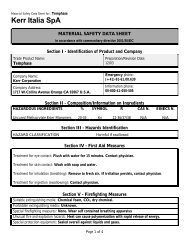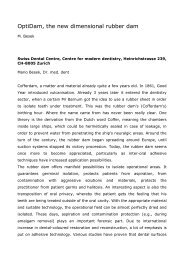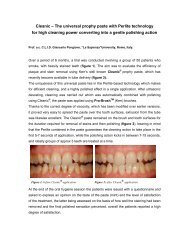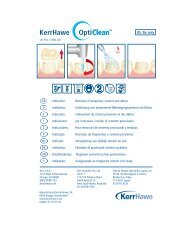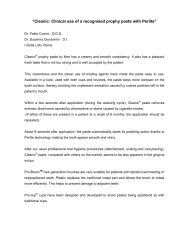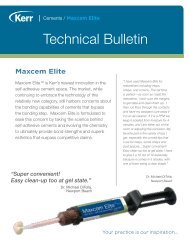Restorative Procedure - Kerr Hawe
Restorative Procedure - Kerr Hawe
Restorative Procedure - Kerr Hawe
You also want an ePaper? Increase the reach of your titles
YUMPU automatically turns print PDFs into web optimized ePapers that Google loves.
for resistance, biocompatibility, and of course<br />
aesthetic appearance. Composite resins have now<br />
been in use for over three decades and in recent<br />
years have become a solution that is adopted<br />
more often, because of their excellent aesthetics<br />
and their ever better mechanical properties (3).<br />
The term composite refers to a combination of at<br />
least two chemically diverse materials, with a distinct<br />
interface to separate the two components. Superior<br />
properties are exhibited when in combination,<br />
opposed to when used separately.<br />
When formulating a composite resin, we identify<br />
three different components:<br />
• Organic matrix;<br />
• Inorganic filler;<br />
• Binding agent.<br />
The organic matrix of the most modern composite<br />
resins consists mainly of the monomer developed<br />
by Bowen in 1957, through a reaction between<br />
one molecule of bisphenol A and two molecules<br />
of glycidyl methacrylate (GMA), yields a viscous<br />
monomer of high molecular weight which is called<br />
BISGMA. In the formulation of the matrix of<br />
composite resins we then find other monomers of<br />
lower molecular weight in lower percentages such<br />
as TEDGMA (triethylene glycol dimethacrylate, the<br />
most used), UEDMA (diurethane dimethacrylate,<br />
sometimes used as the sole component of the<br />
matrix), MMA (methyl methacrylate) and others of<br />
less importance and little used.<br />
The second component of a composite resin is<br />
the inorganic filler, which is added to the matrix<br />
to increase its resistance characteristics, which<br />
are otherwise insufficient, such as hardness,<br />
resistance to compression, resistance to wear<br />
and impermeable.<br />
The fillers can be classified on the basis of their<br />
chemical nature into fillers based on silicon dioxide<br />
or colloidal silica, quartz, vitreous materials, other<br />
metals or zirconium.<br />
On the other hand, Bayne in 1994 suggested the<br />
following subdivision based on the diameter of<br />
the particles:<br />
• mega fillers (from 2 to 0.5 mm)<br />
• macro fillers (from 100 to 10 µm)<br />
• medium fillers (from 10 to 1 µm)<br />
• mini fillers (from 1 to 0.1 µm)<br />
• micro fillers (from 0.1 to 0.01 µm)<br />
• nano fillers (from 0.01 to 0.005 µm)<br />
Based on production techniques, conventional or<br />
traditional fillers are produced by trituration of the<br />
inorganic substances listed above, obtaining a<br />
macro filler with particles of irregular shape and<br />
size, which require little monomer to become wet,<br />
therefore conferring less viscosity, but they make<br />
the restoration difficult to finish and polish and<br />
also favour the formation of micro fractures.<br />
Fillers obtained by precipitation of pyrogenic silica<br />
at high temperatures, introduced successively,<br />
18<br />
Your practice is our inspiration.




